How to connect a differential machine: possible connection diagrams + step-by-step instructions
Electrical wiring carries many risks for the home, its occupants and equipment. Most of them can be eliminated by installing an automatic residual current switch (RCCB) - a difavtomat.
This device provides protection against leakage current, network overload, short circuit and electric shock. It is important to know how to connect a differential circuit breaker in order to maximize the protection of equipment, human health and property.
The content of the article:
Operating principle of the automatic machine
The difavtomat has three built-in mechanisms, each of which turns off the voltage in a certain situation:
- presence of leakage current;
- unexpected short circuit;
- power overload of the electrical network.
Leakage is determined using a differential transformer, which responds to the difference between the current values at “zero” and “phase”.
The difference can occur when a person comes into contact with live objects or when electrical appliances are partially shorted to the surfaces surrounding them. In such cases the automatic device is triggered and turns off the electricity.
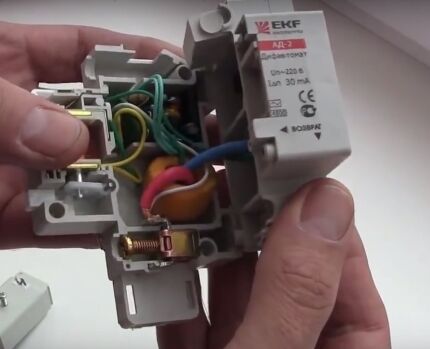
The short circuit sensor responds to high current. And the connection of excess load is determined by the heating of the metal thermoplate, which opens the electrical network when its own temperature rises.
Thus, any dangerous situation related to electrical wiring is quickly identified by the automatic device and ends with a protective shutdown of voltage in the problem circuit.
Possible connection diagrams
The methods of connecting difavtomats differ not so much in the layout of the wires, but in the number and characteristics of the devices themselves. Therefore, it is important to understand the possible schemes, find out the features of their application and connection in order to ensure maximum protection for yourself and household appliances for minimal money.
System with a single difavtomat
The first connection diagram for a difavtomat implies the presence of only one protective device. It is mounted immediately after the electric meter. All available electrical circuits are connected to the RCBO output.
Should, if possible, be installed at the beginning of each circuit limit switch. This is necessary so that it is possible to carry out electrical wiring repairs in one room without turning off the lights in the entire apartment.
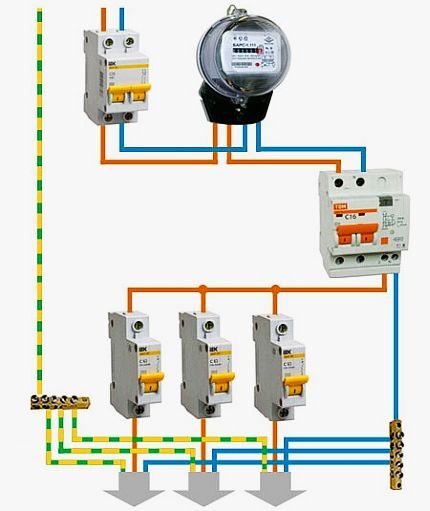
The maximum current load of the protective device must be correlated with the power of the simultaneously connected equipment and the characteristics of the electric meter. It is desirable that the RCBO operates earlier than the fuses on the meter.
The supply wires from the electric meter are connected to the only difavtomat from above, and those to which the intra-apartment wiring is connected come out from below. The advantage of this scheme is its simplicity, low cost and minimal need for space to place the RCBO.
The disadvantage of the described electrical protection option is the inconvenience of finding the reason for knocking out the automatic device.Since the entire apartment is de-energized at once, it is quite difficult to determine in which room the cause of the RCBO operation is located.
In addition, if a problem with the electrical wiring occurs in only one room, then the voltage cannot be turned on in the entire apartment. To avoid the disadvantages of a scheme with a single automatic switch, it is recommended to take a closer look at other options for connecting it.
Two-level connection system
The two-level system of difavtomats is more reliable and convenient to maintain. At the first level there is a RCBO connected after the electric meter, through which the entire load passes. The wires coming out of it are connected in parallel to several automatic circuit breakers, the number of which is equal to the number of electrical circuits in the apartment.
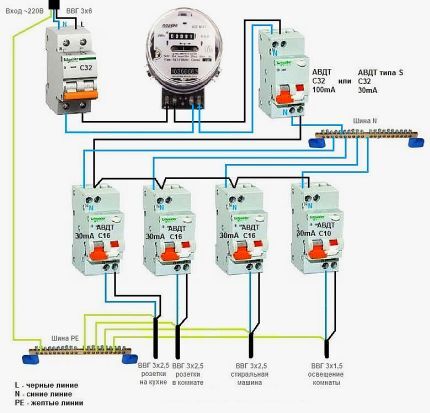
Level 2 devices may be less powerful and have a lower threshold leakage current. This will save money while maintaining the efficiency of the equipment.
In theory, a separate protective device can be connected to each household appliance, but in practice this is impractical. Sometimes the most powerful equipment in the bathroom is separated into a separate circuit - a washing machine, an electrified shower cabin, a jacuzzi.
The advantages of a two-level connection scheme for a differential machine include:
- Reliability and safety. The first-level difavtomat is, in fact, redundant and is capable of turning off power simultaneously with the protective devices that follow it.
- Ease of finding an electrical circuit, in which the malfunction occurred.
- Possibility to turn off only one room from electricity for the period of repair work.
The only disadvantages of this option for protecting the electrical network are the need to purchase several automatic devices and the difficulty in allocating space for their installation.
It is rational to use a two-level scheme in a branched network with several electrical circuits. If a minimum of equipment is connected to the electric meter, then installing a single automatic device will be sufficient.
Single-level difavtomat system
The single-level connection diagram for difavtomats resembles a two-level one. The only difference is the absence of a common RCBO. Proponents of this option emphasize that it saves money and space by eliminating one protective device from the circuit.
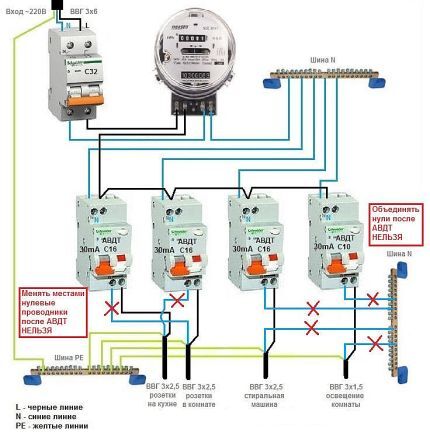
The disadvantage of this installation method is the absence of a backup device in the circuit, which would provide an additional level of protection. As for the installation features and areas of application of the distributed single-level scheme, they are identical to those in the two-level version.
Installation of difavtomat without grounding
The schematic diagram for connecting difavtomats in the absence of grounding is practically no different from the single-level and two-level options discussed above. The only difference is the absence of a special core, which must be suitable for each electrical point, ensuring the removal of current from the device body in the event of a violation of its electrical insulation.
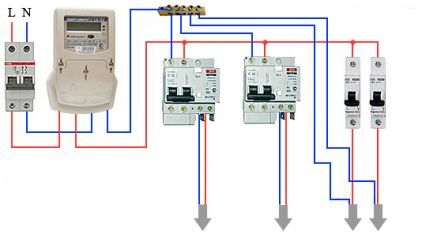
In old high-rise buildings and private houses grounding system it was simply not provided for. As a result of such hindsight, there was a risk of electric shock to a person when coming into contact with equipment and structures that accidentally became energized.
The difavtomat functionally replaces the ground wire, breaking the electrical circuit within hundredths of a second after detecting a current leak. During this time, the electric shock does not have time to harm a person, and the impact is limited to a maximum of mild fright.
Additionally, the RCBO protects equipment from overloads and short circuits, which compares favorably with conventional grounding.
The differences in the operation of differential circuit breakers and RCDs are listed and discussed in the article, devoted to the comparison of two types of protective devices for electrical wiring.
Scheme for three-phase network
Sometimes it becomes necessary to install a difavtomat in a building where a 380V network is connected. This could be a garage, a store or a small industrial space. In this case, the same circuits are used as in the 220V network. Only the design of the difavtomat itself differs.
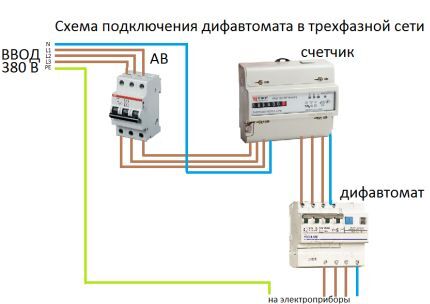
The RCBO for three-phase voltage has four input terminals and the same number of output terminals, from which wires go to electrical appliances. It is desirable that there is a grounding conductor in the electrical circuit. But in the absence of such, the difavtomat will definitely react to the leakage current and de-energize the room.
The advantages and disadvantages of different options for connecting RCBOs to a three-phase network are the same as with a voltage of 220V.
Features of installation of selective automatic machines
Most selective automatic circuit breakers have the index S in their name. These devices differ from conventional RCBOs in their increased response time when detecting a leakage current.
Selective difautomatic devices are used only as the main device in two-level circuits. They provide individual activation of second-level devices without cutting off the power supply to the entire network.
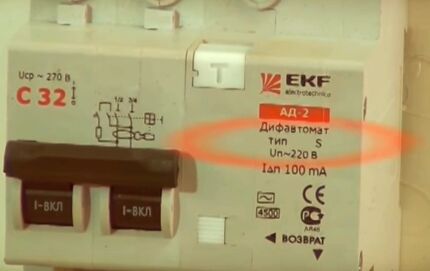
Their feature is as follows. When a leakage current appears, it can be detected by difautomats of both levels. Which one goes off first is left to chance, but usually both turn off the power.
Increasing the response time of the central RCBO allows the second-level difautomatic device to operate first. Thus, as a result of a malfunction, only one electrical circuit is switched off, and the rest of the apartment continues to remain energized. The use of selectivity allows the use of difautomatic devices with the same threshold leakage current.
There is another connection scheme, without a selective device, which allows for selective shutdown of the second level RCBO when a leakage current appears.
To do this, the central device is selected with a threshold parameter value of 100 mA, and the secondary devices - 30 mA. In this case, the second-level automatic circuit breakers will operate first, selectively turning off only one electrical circuit. However, 100% performance of such a scheme is not guaranteed.
Priority when purchasing should be given to selective automatic machines, which provide greater reliability and convenience.
Step-by-step instructions for installing the difavtomat
Installing the difavtomat is not difficult and can be done independently without special training.
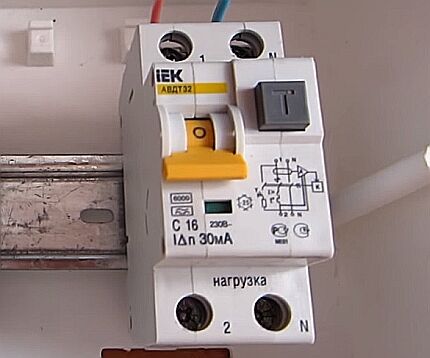
The sequence of actions is as follows:
- Check the integrity of the RCBO and the functionality of its toggle switches.
- Fix the difavtomat on a special metal DIN rail at its permanent location.
- Turn off the voltage in the apartment and check its absence with an indicator.
- Strip the power cores in the cable and connect them to the two upper terminals of the difavtomat. The blue color is usually connected to the “zero” of the RCBO, yellow or brown to the ground loop, and the third color to the “phase” of the device.
- Connect the wires that supply voltage to the apartment or to subsequent protective devices to the lower terminals of the difavtomat.
- Apply voltage to the RCBO and check the operation of the device.
To test the automatic machine, it has a special “T” button.
When it is pressed, a leakage current appears in the electrical circuit, which should lead to the device operating and cutting off the voltage. If the RCBO does not respond, it means it is faulty and must be replaced.
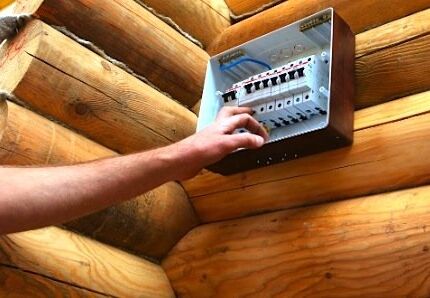
IN electrical network of the apartment The difavtomat is only an intermediate link that provides additional protection, so its installation will not cause difficulties.
Helpful installation tips
Installation of a difavtomat has many small nuances that will help make the equipment operate efficiently and reliably.
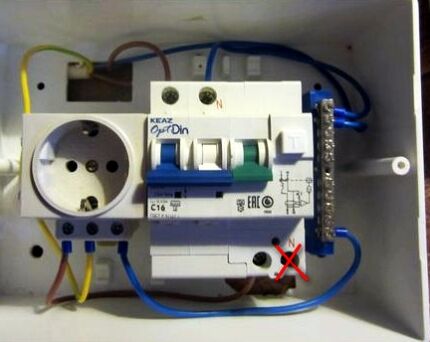
Advice in electrical engineering should not be neglected, so the following recommendations should be taken carefully:
- When connecting wires to a differential circuit breaker, polarity must be observed. The “zero” terminal is designated as N, and the “phase” terminal is designated 1 or 2.
- Connection work must be carried out with all wires completely de-energized.
- The best safety is ensured by a two-level scheme with a selective automatic switch of the first level.
- It is worth selecting the power of second-level difavtomats in accordance with the expected load on the electrical circuit in each room.
- It is impossible to combine the output “zero” and “phase” of the difavtomat with electrical wires not connected to it, even if they come from parallel connected RCBOs.
- The “zero” coming out of the difavtomat should not come into contact with the grounding conductor.
When fixing the wire in the terminal, you need to make sure that no insulation gets into the connector. Poor contact can lead to overheating of the difavtomat and its breakdown.
If most of the recommendations described above are not followed, the RCBO simply will not function properly. It may “knock out” when a load is connected or may not respond to current leakage at all. Therefore, the electrical connection diagram must be taken seriously.
Conclusions and useful video on the topic
You will learn from the following videos what difficulties you may encounter when connecting protective devices.
Testing a two-level selective and non-selective scheme:
Internal structure of the difavtomat:
Analysis of various circuit diagrams for connecting difavtomats (3 parts):
Connecting a protective differential circuit breaker is a simple process. The main condition for quick installation is strict adherence to the recommended electrical diagrams. In this case, self-installation of protective devices will be possible the first time, and the RCBOs themselves will reliably serve for many years.
Would you like to share your own experience in connecting a differential machine? Do you know the subtleties of installing the device that are not given in the article? Please write comments, ask questions, post photos in the block below.




Good night! What to do, tell me! In one of the groups of sockets, during installation, somewhere the zero got into a phase (it is not possible to find out where, since the finishing has already been completed and there is no access to the switching boxes). The differential does not turn on on this group. Is it possible to connect such a group of sockets by insulating the ground everywhere or by connecting it to zero?
Good afternoon, Ilya. I understood from the post that the power supply diagram provides for connecting groups of sockets through separate circuit breakers.
You can find a shorted socket as follows:
— turn off the group machine;
— open all the sockets of this group and check that there is no voltage (wires may come from other groups);
- discard the wires in all sockets;
— check the presence of voltage in the sockets of other groups (there are cases when the wires of groups are confused - this is how the zeros end up on other phases);
— turn on the machine.
If it’s a matter of mixed-up zeros and phases (I admit, I couldn’t come up with such a mix-up), then the machine will hold. After making sure that there is no short circuit without connected sockets, turn off the machine again and connect the wires of any one socket. If everything is fine, repeat connecting the remaining sockets one by one until you find the culprit.
It may turn out that there will be a short circuit without connected sockets. This is a signal that phases and zeros are mixed up, for example, in distribution boxes. There were cases, I remember, when installers confused the wiring of different groups. The only way out here is to cut and thread the wires again.
Avlt doesn't work. The electrician got something wrong with the N circuit breaker for 16 A and 25. The test button works, but when any load is turned on, the RCD and circuit breaker are switched off. Tell me how to solve it.
Most likely, either the zero is in contact with the ground (they can try to connect a lighting lamp in the lamp instead of the zero through the ground), or somewhere the zero came to the device from another differential. Such mistakes are very common when people get lazy and start throwing wires from neighboring sockets, and not through boxes.
If one is turned off the other does not work, then the zeros are mixed up somewhere or twisted into one. We need to look at what groups feed and where they could intersect.
An old house built in the 60s. There is no protective grounding. The new electrical wiring in the apartment uses European sockets.Do I need to connect a green ground wire to the outlet? On the electrical panel, as the electrician said, the neutral and ground wiring are combined.
This is a protective grounding. Be sure to connect and install RCD or differential automata on the connection line for devices using water (dishwashers, washing machines).
Everything is fine, it’s not clear, but why do we need a limit switch? And what will put pressure on him/let him go?